Ultra-fine Airborne Particles and Your Health
There is a long history of disease caused by inhaled particles that stretches from Agricola and Paracelsus in the 14th century up to the present.
In the 20th Century the twin scourges of asbestos and crystalline silica (quartz) exerted a terrible toll of death and disease. The bad old days when these dust related lung diseases were common are fortunately gone but as we move into the 21st century a new particle type, the ultra-fine particle, has emerged as one with a potential role in causing disease.
What are ultra-fine particles and where do they come from?
Ultrafine particles (UFPs) are particulate matter of nanoscale size (less than 0.1 μm or 100 nm in diameter).
This size class of ambient air pollution particles, which are far smaller than the regulated PM10 and PM2.5 particle classes, are believed to have several more aggressive health implications than those arising from larger particulates.
There are two main divisions that categorise types of UFPs. UFPs can either be carbon-based or metallic, and then can be further subdivided by their magnetic properties.
UFPs are the main constituent (by number) of airborne particulate matter. UFPs arise from a range of indoor sources that include printers and copiers, cooking, tobacco smoke, vaping, candles, chimney cracks and vacuum cleaners.
Those indoor sources are often considerably supplemented by the penetration of contaminated air from outside, where vehicles and industry are the major contributors.
Health effects
Unlike their larger PM10 and PM2.5 brethren, UFPs that are inhaled, because they are very small, can penetrate tissue and / or be absorbed directly into the bloodstream where effects may become apparent quickly.
Exposure to UFPs, even if the underlying materials are not very toxic, may cause oxidative stress, inflammatory mediator release, and could induce heart disease, lung disease, and other systemic effects. A robust association has been observed between fine particulate levels and both lung cancer and cardiopulmonary disease.
The exact mechanism through which UFP exposure leads to health effects remains to be fully understood, but effects on blood pressure may play a role. It has recently been reported that UFP is associated with an increase in blood pressure in schoolchildren with the smallest particles inducing the largest effect.
Reducing exposure to UFPs indoors
Standard HEPA filters as fitted to almost all air cleaners only collect particles down to around PM2.5 although specialist HEPA filters such as ‘HyperHEPATM clean room grade filters’ can collect particles across much of the ultra-fine spectrum.
Ion generators have been found to have mediocre UFP removal performance and ultraviolet germicidal irradiation (UVGI) have demonstrated very limited or no UFP removal capabilities.
In addition, all filter-based devices, whatever the underlying technology, share the same shortcoming which limits their effectiveness. They only clean the air that passes through the device, not all the air in the room.
How Airora can help
The advent of the Airora air purifier offers a new approach which promises to reduce the number of ultra-fine particles throughout a room.
In this approach, the ultra-fines are subject to in-situ oxidation by hydroxyl radicals. Oxidation by hydroxyls is known to fragment organic carbon ultra-fine particles, which typically constitute most ultra-fines indoors, changing them over time from solids to harmless gasses.
Research on this important subject continues!
|
The independent expert panel of the National Asthma Council Australia have presented the Airora Pyramid with its trusted Sensitive Choice blue butterfly award for the benefit it can bring to people with asthma and allergies. Sensitive Choice is a not for profit global program extending over 60 countries, so that people with asthma and allergies can look out for the reassuring blue butterfly around the world. |
You can find out all about Airora at airora.com
And contact us at support@airora.com
|
Copyright Airora 2024 |
1 |
V1.1 |
